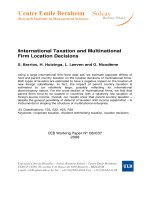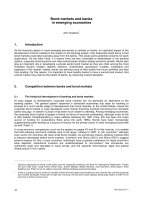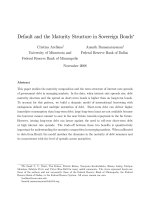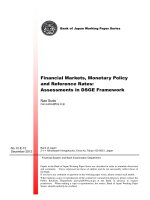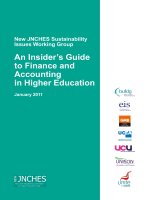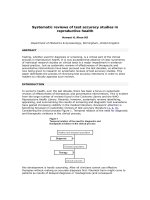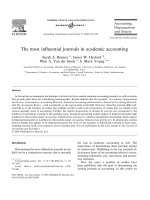Studies in International Taxation docx
Bạn đang xem bản rút gọn của tài liệu. Xem và tải ngay bản đầy đủ của tài liệu tại đây (17 MB, 336 trang )
This Page Intentionally Left Blank
Studies
in
International Taxation
A
National Bureau
of
Economic Research
Project Report
Studies
in
International
Taxation
Edited
by
Albert0 Giovannini,
R.
Glenn Hubbard,
and
Joel
Slemrod
The
University
of
Chicago
Press
Chicago
and
London
The University of Chicago Press, Chicago 60637
The University of Chicago Press, Ltd., London
0
1993 by the National Bureau
of
Economic Research
All rights reserved. Published 1993
Paperback edition 1996
Printed in
the
United States of America
02 01 00 99 98 97 96 2
3
4
5
ISBN: 0-226-29701-2 (cloth)
ISBN: 0-226-29702-0 (paper)
Library
of
Congress Cataloging-in-Publication Data
Studies in international taxation
/
edited by Alberto Giovannini, R. Glenn
Hubbard, Joel Slemrod.
cm (A National Bureau
of
Economic Research project report)
2. Income tax-For-
eign income. 3. Investments, Foreign-Taxation. 4. Capital levy. I.
Giovannini, Alberto. 11. Hubbard, R. Glenn. 111. Slemrod, Joel.
IV.
Series.
HJ2347378 1993
336.24’34~20 93-9797
CIP
p.
Includes bibliographical references and index.
1. International business enterprises-Taxation.
@
The paper used in this publication meets the minimum requirements
of
the American National Standard for Information Sciences-Permanence
of Paper
for
Printed Library Materials, ANSI 239.48-1984.
National
Bureau
of
Economic
Research
Officers
George
T.
Conklin,
Jr.,
chairman
Paul
W.
McCracken,
vice chairman
Martin Feldstein,
president and chief
executive oficer
Geoffrey Carliner,
executive director
Charles A. Walworth,
treasurer
Sam Parker,
director of$nance and
administration
Directors at Large
John H. Biggs Martin Feldstein Peter
G.
Peterson
Andrew Brimmer George Hatsopoulos Douglas D. Purvis
Carl F. Christ Lawrence R. Klein Robert V. Roosa
George
T.
Conklin, Jr. Franklin A. Lindsay Richard
N.
Rosett
Don
R.
Conlan Paul W. McCracken Bert Seidman
Kathleen B
.
Cooper
Jean
A.
Crockett
George C. Eads
Leo
Melamed
Robert
T.
Parry
Directors by University Appointment
Jagdish Bhagwati,
Columbia
William C. Brainard,
Yale
Glen G. Cain,
Wisconsin
Franklin Fisher,
Massachusetts Institute
of
Saul H. Hymans,
Michigan
Marjorie B. McElroy,
Duke
Technology
Eli Shapiro
Donald
S.
Wasserman
James L. Pierce,
California, Berkeley
Andrew Postlewaite,
Pennsylvania
Nathan Rosenberg,
Stanford
Harold
T.
Shapiro,
Princeton
Craig Swan,
Minnesota
Michael Yoshino,
Harvard
Arnold Zellner,
Chicago
Directors by Appointment
of
Other Organizations
Marcel Boyer,
Canadian Economics
Rueben C. Buse,
American Agricultural
Richard
A.
Easterlin,
Economic History
Gail Fosler,
The Conference Board
A.
Ronald Gallant,
American Statistical
Robert
S.
Hamada,
American Finance
Association
Economics Association
Association
Association
Association
Directors Emeriti
Moses Abramovitz
Emilio
G.
Collado
Thomas D. Flynn
Gottfried Haberler
Geoffrey
H.
Moore
James J. O’Leary
Charles Lave,
American Economic
Rudolph A. Oswald,
American Federation
of
Association
Labor and Congress
of
Industrial
Organizations
Development
Business Economists
CertiJied Public Accountants
Dean-P. Phypers,
Committee for Economic
James F. Smith,
National Association
of
Charles
A.
Walworth,
American Institute
of
George B. Roberts
William
S
.
Vickrey
Relation
of
the Directors to the
Work
and Publications
of
the
National Bureau
of
Economic Research
1.
The object of the National Bureau of Economic Research is to ascertain and to present to
the public important economic facts and their interpretation in a scientific and impartial manner.
The Board of Directors is charged with the responsibility of ensuring that the work of the National
Bureau is carried on in strict conformity with this object.
2.
The President of the National Bureau shall submit to the Board of Directors,
or
to its
Executive Committee, for their formal adoption all specific proposals for research to be instituted.
3.
No research report shall be published by the National Bureau until the President has sent
each member of the Board a notice that a manuscript is recommended for publication and that in
the President’s opinion it is suitable for publication in accordance with the principles of the
National Bureau. Such notification will include an abstract or summary of the manuscript’s con-
tent and a’response form for
use
by those Directors who desire a copy of the manuscript for
review. Each manuscript shall contain a summary drawing attention to the nature and treatment
of the problem studied, the character of the data and their utilization in the report, and the main
conclusions reached.
4.
For each manuscript
so
submitted, a special committee of the Directors (including Directors
Emeriti) shall be appointed by majority agreement of the President and Vice Presidents (or by the
Executive Committee in case
of
inability to decide
on
the part of the President and Vice Presi-
dents), consisting of three Directors selected as nearly as may be one from each general division
of
the Board. The names of the special manuscript committee shall be stated to each Director
when notice of the proposed publication is submitted to him. It shall
be
the duty of each member
of the special manuscript commmittee to read the manuscript. If each member of the manuscript
committee signifies his approval within thirty days of the transmittal of the manuscript, the report
may be published. If at the end of that period any member of the manuscript committee withholds
his approval, the President shall then notify each member
of
the Board, requesting approval or
disapproval
of
publication, and thirty days additional shall be granted for this purpose. The
manuscript shall then not be published unless at least a majority of the entire Board who shall
have voted on the proposal within the time fixed for the receipt of votes shall have approved.
5.
No manuscript may be published, though approved by each member of the special manu-
script committee, until forty-five days have elapsed from the transmittal of the report in manu-
script form. The interval is allowed for the receipt of any memorandum of dissent or reservation,
together with a brief statement of his reasons, that any member may wish to express; and such
memorandum of dissent or reservastion shall be published with the manuscript if he
so
desires.
Publication does not, however, imply that each member of the Board has read the manuscript,
or
that either members of the Board in general
or
the special committee have passed on its validity
in every detail.
6. Publications of the National Bureau issued for informational purposes concerning the work
of the Bureau and its
staff,
or
issued to inform the public of activities of Bureau staff, and volumes
issued as a result of various conferences involving the National Bureau shall contain a specific
disclaimer noting that such publication has not passed through the normal review procedures
required in this resolution. The Executive Committee of the Board is charged with review of all
such publications from time to time to ensure that they do not take on the character of formal
research reports
of
the National Bureau, requiring formal Board approval.
7.
Unless otherwise determined by
the
Board or exempted by the terms of paragraph
6,
a copy
of this resolution shall
be
printed in each National Bureau publication.
(Resolution adopted October
25.
1926,
as
revised through September
30, 1974)
Contents
Acknowledgments ix
Introduction
1
Alberto Giovannini, R. Glenn Hubbard, and Joel
Slemrod
I.
INTERNATIONAL
FINANCIAL
MANAGEMENT
1.
Taxes and the Form of Ownership
of
Foreign
Corporate Equity
13
Roger H. Gordon and Joosung
Jun
Comment:
Alberto Giovannini
2.
Impacts of Canadian and U.S. Tax Reform on
the Financing
of
Canadian Subsidiaries
of
U.S. Parents
47
Roy
D.
Hogg and Jack
M.
Mintz
Comment:
Neil Bruce
3.
The Effects
of
U.S.
Tax Policy on the Income
Repatriation Patterns of
U.S.
Multinational
Rosanne Altshuler and
T.
Scott Newlon
Corporations
77
11.
INVESTMENT
4.
Taxation and Foreign Direct Investment in
the United States:
A
Reconsideration of
the Evidence
119
Alan J. Auerbach and Kevin Hassett
Comment:
James M. Poterba
vii
viii
Contents
5.
On the Sensitivity of R&D to Delicate Tax
Changes: The Behavior of
U.S.
Multinationals
in the
1980s
149
James R. Hines, Jr.
Comment:
Bronwyn
H.
Hall
6.
The Role of Taxes in Location and Sourcing
Decisions
195
G. Peter Wilson
Comment:
R.
Glenn Hubbard
111.
INCOME
SHIFTING
7.
Explaining the
Low
Taxable Income of Foreign-
Controlled Companies in the United States
Harry Grubert, Timothy Goodspeed, and
Deborah Swenson
Comment:
Jeffrey K. MacKie-Mason
8.
Income Shifting in U.S. Multinational
Corporations
277
David Harris, Randall Morck, Joel Slemrod, and
Bernard Yeung
Comment:
John Mutti
237
Contributors
Author Index
Subject Index
309
31
1
315
Acknowledgments
This volume includes nine papers that were prepared as part of a research
project on international aspects of taxation, undertaken by the National Bu-
reau of Economic Research. The authors present new empirical studies
of
effects of tax policy
on
decisions of multinational corporations in three areas:
international financial management, investment, and income shifting. This
research was the focus
of
a conference attended by academics, policymakers,
and representatives of international organizations. The conference was held in
New York
on
September
26-28,
1991.
The editors
are
grateful to the Ford Foundation and the Starr Foundation for
financial support of this project. The success of the conference and the proj-
ect also depended on the efforts of Robert Allison, Kirsten
Foss
Davis, Ilana
Hardesty, and Jane Konkel of the National Bureau of Economic Research.
Alberta Giovannini,
R.
Glenn Hubbard, and Joel
Slemrod
ix
This Page Intentionally Left Blank
Introduction
Alberto Giovannini,
R.
Glenn Hubbard, and Joel Slemrod
In recent years, as multinational corporations have played a greater role in the
global economy, interest in international aspects of capital income taxation
has also rapidly increased. In the United States, discussions of problems
of
U.S. competitiveness and the position of the United States in the world econ-
omy have prompted public debate on international taxation issues. In Europe,
policy discussions on capital income taxation have increased in the wake of
the announcement that several European countries have liberalized capital
flows, of the single European market, and of the Economic and Monetary
Union. An experts’ committee of the European Commission proposed, in
early
1992,
a substantial harmonization
of
corporate income tax structures.
These developments raise the question of whether the existing structure of
multinational taxation was viable only in the highly regulated international
financial system and under the relative restrictive controls on international
capital movements that characterized the world economy in the post-World
War
I1
period.
Is
the current system of taxing income-and multinationals in
particular-inconsistent with the trend toward liberalized world financial
flows and increased international commercial competition?
This question has begun to attract the attention
of
the academic community.
Its answer depends on the effect
of
taxes on saving, on capital formation in
different countries, on the pattern of international borrowing and lending, on
international competitiveness, and on the opportunities for tax avoidance.
Alherto Giovannini is Jerome A. Chazen Professor
of
International Business at Columbia Uni-
versity, a research fellow at the Centre for Economic Research in London, and member and coor-
dinator of the Council of
Experts
of the Italian Treasury Ministry. R. Glenn Hubbard is professor
of economics and finance at the Graduate School of Business, Columbia University, and former
deputy assistant secretary (tax analysis),
U.S.
Department of the Treasury. Joel Slemrod is Jack
D.
Sparks Whirlpool Corporation Research Professor in Business Administration and professor of
economics at the University of Michigan. All
are
research associates
of
the National Bureau of
Economic Research.
I
2
A.
Giovannini,
R.
G. Hubbard, and
J.
Slemrod
Much of the recent research in this area combines newly developed models in
the fields of public finance and international economics.
At the same time, policymakers in the United States have indicated a will-
ingness to reconsider the entire system of taxation of income from inbound
and outbound investment.
In
July 1992, the House Ways and Means Commit-
tee held hearings
on
a comprehensive and controversial package of tax pro-
posals affecting U.S. and
non-U.S.
multinational businesses
(H.R.
5270,
The
Foreign Income Tax Rationalization and Simplification Act of 1992). The
Bush administration signaled its interest in reform of the international tax sys-
tem when then Secretary of the Treasury Nicholas Brady directed Treasury’s
Office of Tax Analysis to launch its own economic analysis.
Broad-based studies of the international taxation system will have to rec-
oncile results of the simplest theoretical models with the complex world of
business finance and investment decisions in the global economy. Conceptual
analyses of capital income taxes in open economies have produced extremely
simple and intuitive propositions
on
the desirability of alternative interna-
tional tax regimes. Among these, the least controversial and the best known is
the proposition
on
the superiority, from a global perspective, of residence-
based capital income taxes, under which the domestic and foreign incomes of
residents of any given country are taxed at the same rate, irrespective of ori-
gin. Residence-based taxation satisfies the criterion
of
capital-export neutral-
ity, often referred to in informal discussions of international capital income
taxation. For multinationals, it is implemented by taxing their worldwide in-
come and allowing an unlimited credit for taxes paid to governments.
Despite the great intellectual appeal of this proposition and despite the fact
that many industrial countries have officially adopted the residence principle
of taxation of international income, capital-export neutrality is not achieved
in practice by any country. There is significant tax discrimination between
domestic- and foreign-source capital income, caused by limitations of tax
credit
on
foreign taxes paid, by the possibility of deferring foreign-source
income, by countries’ differences
in
the degree
of
integration between the
taxation of corporate and personal income, and by the differences in the defi-
nitions of tax bases-including how foreign-source and domestic-source in-
come are delineated.
Even if these problems could be eliminated,
it
is unlikely that a pure
residence-based system of capital income taxation could be put in place, be-
cause tax enforcement is by its very nature territorial. The enforcement of tax
laws can seldom, and only with great difficulty, be extended outside the
boundaries of a country. The territorial nature
of
tax enforcement and the dif-
ficulties of recovering taxes from overseas income have led countries to tax
income produced by foreign residents in their
own
territory. Hence, the move-
ment to a pure residence-based system would require relinquishing tax reve-
nue from income produced by foreign investments, a reform that would en-
counter substantial political resistance.
3
Introduction
Do
observed deviations from capital-export neutrality give rise to signifi-
cant losses of efficiency? More generally, how does the world allocation of
productive capital, research and development facilities, and tax revenues re-
spond to tax incentives? These questions have straightforward answers in
simple theoretical models, but answers in practice are more difficult because
of the complexity of real-world tax rules, financial management, and invest-
ment decisions. This difficulty is compounded by the fact that the answers to
these questions have important implications for the appropriate direction of
policy. For example, if cross-country differences in corporate tax rates would
give rise to significant income shifting but little incentive to shift production
facilities, then international coordination efforts ought to be focused
on
har-
monizing corporate statutory tax rates. If, alternatively, income shifting were
insignificant but real investment were very sensitive to taxation, then attention
should be given to effective tax rates, which depend not only
on
statutory tax
rates but also
on
the definition of the tax base.
The efficiency of factor allocation is not the only criterion by which inter-
national tax policy must be judged in practice. The distribution of tax reve-
nues across countries is also a continuing concern, especially since some
countries deliberately set their tax structure to make it attractive for the multi-
national corporation to shift taxable income into their jurisdiction. Attempts
by other countries to limit the loss of revenue because of income shifting have
contributed to the extreme complexity of the tax rules that apply to multi-
nationals. This complexity exacts a resource cost not only through the ex-
penses incurred in complying with the rules but also in the difficulty and un-
certainty added to the long-term planning process. Although equity and
simplicity of operation should be kept in mind as criteria for judging interna-
tional tax policy, because of the difficulty of analyzing these issues most eco-
nomic research has to this point focused
on
the incentive effects
of
taxation
on
factor allocation.
Some recent attempts to identify the tax incentives to international invest-
ments that account in a realistic way for the existing tax rules are the cost-of-
capital calculations based on the methods developed by King and Fullerton
(1984).
Devereux and Pearson
(1991)
use the King-Fullerton techniques to
compute the cost of capital of a number of cross-border investments and find
that, at least for European countries, differences in the cost of capital for dif-
ferent types of cross-border investments are very large. This puzzling evi-
dence adds to less systematic descriptions, typically found in publications
of
accounting firms, of the opportunities offered by the numerous loopholes cre-
ated by international inconsistencies in national tax rules. Even the Devereux-
Pearson calculations are based
on
very rudimentary assumptions about the
details of how multinationals are taxed and the dimensions in which firms can
adjust their financial and accounting behavior in response to taxes.
Very large differences in costs of capital and a bewildering variety of legal
means that allow multinational corporations to significantly reduce their taxes
4
A.
Giovannini,
R.
G.
Hubbard, and
J.
Slemrod
paid have not been exploited fully; that is, such profit opportunities apparently
have not been taken to the limit. This puzzle raises questions about the appro-
priateness of many models currently used in international taxation that predict
the (often instantaneous) disappearance of these profit opportunities and on
which welfare evaluations of alternative tax regimes are based. In other
words, if apparent profit opportunities are not eliminated by arbitrage, exist-
ing models are likely not accounting for important factors that influence the
finance and investment decisions of multinational corporations in the real
world.
It is clear that the conceptual models that frame our understanding of inter-
national taxation policy have not caught up to the new realities of the financial
and investment decisions in the global economy. Before building new models,
however, we believe that it is important to examine the relevant empirical
facts. That is the goal of this volume. The papers that follow exploit a variety
of
data sets, many of which are new, to provide evidence on three crucial
aspects of multinational corporations’ responses to international tax incen-
tives:
(1)
international financial management,
(2)
international investment,
and
(3)
international income shifting. Only with an understanding of these
issues can we assess the likely impact of alternative tax regimes and evaluate
these alternatives according to their economic impact, their simplicity of op-
eration. and their distribution of tax revenues across countries.
International Financial Management
The first two papers are concerned with the effect of taxation on interna-
tional financial management. Roger
H.
Gordon and Joosung Jun investigate
the implications of the fact that the tax law treats differently the two ways
individuals can buy equity in foreign firms-directly by purchasing these
shares in the securities market (portfolio investment) or indirectly by investing
in a domestic corporation that then uses the funds to invest in foreign firms
(foreign direct investment). Either approach allows investors to take advan-
tage of the potentially more favorable returns abroad and to diversify their
portfolios. Of course, the relative importance of portfolio equity investment
versus foreign direct investment will be affected by more than just tax factors.
When corporations invest abroad, they acquire both ownership and control
over the foreign firms, whereas portfolio investors merely acquire ownership.
This makes corporate investments more attractive to the extent to which there
are synergy gains from joint operations of the domestic and foreign firms. In
addition, through use of capital controls, some countries attempt to discour-
age portfolio investment abroad.
Gordon and Jun analyze empirically how tax and nontax factors affect the
relative importance of portfolio equity investments versus foreign direct in-
vestments, using aggregate data from ten foreign countries on the composition
of portfolio and direct ownership of
U.S.
equity for the period 1980-89.
5
Introduction
Their analysis of these data shows that the composition of equity flows does
differ dramatically among these countries and that at least part of the expla-
nation appears to be tax differences. However, behavior did not seem to
change much during the
1980s,
in spite of the many large changes in tax rates
that occurred during that period. Part of the explanation for the lack of re-
sponse appears to be the importance of capital controls in many of the sample
countries. Another problem, making inference more difficult, is that tax pol-
icy itself appears to have been endogenous-countries in which investors
could more easily invest abroad were more likely to have lower tax distortions
and to impose capital controls. In principle, the increasing international inte-
gration of financial markets and the steady reduction of capital controls should
lead to increasing responsiveness of the composition of international capital
flows to tax distortions. As a result, countries will be under increasing pres-
sure to reduce these tax distortions, and past behavior suggests that they will
in fact respond to this pressure.
In the second paper, Roy
D.
Hogg and Jack M. Mintz examine the impact
of
U.S.
and Canadian tax reforms on the financing of
U.S.
multinationals
operating in Canada. They use a unique time-series data file, compiled by
Arthur Andersen
&
Co., with information on twenty-eight U.S. companies
operating in Canada.
After a thorough review of the tax reforms in the United States and Canada,
the authors present three hypotheses about the impact of these reforms:
(1) that U.S. subsidiaries in Canada would increase local debt financing,
(2)
that they would increase cross-border charges, and
(3)
that they would
increase dividends paid out to the
U.S.
parent corporation. The authors con-
clude that in general these hypotheses are confirmed by the data although,
they note, there are both tax and nontax explanations of the results. They find
a dramatic increase both in the number of companies issuing dividends and in
dividend payout ratios from the
1983-85
subperiod to the
1987-89
subper-
iod. In the latter subperiod, the average ratio of dividends paid to net income
was close to
100
percent when companies chose to pay dividends.
Companies that tended to pay dividends also paid more of their income to
U.S.
parents in the form of cross-border charges. Hogg and Mintz found little
change in aggregate debt-asset ratios over the two subperiods, but on a firm-
by-firm basis the debt-asset ratios increased for a majority of companies and
fell for the remainder; the increase in debt-asset ratios was found to be signif-
icant. They did not, however, find a significant increase in cross-border
charges, as would have been expected after the Tax Reform Act of
1986.
A final way in which tax policy affects international financial management
decisions
of
multinational corporations is its influence on dividend policy de-
cisions within the multinational enterprise. Rosanne Altshuler and T. Scott
Newlon, in chapter
3,
use new data from
1986
corporate income tax returns
to study effects of taxes on decisions by foreign subsidiaries to repatriate div-
idends to
U.S.
parent corporations. The authors stress three features of the
6
A.
Giovannini,
R.
G.
Hubbard, and
J.
Slemrod
treatment of foreign-source income under U.S. tax laws: (1) deferral (because
U.S. tax
on
foreign-source income of
U.S.
firms is delayed until the income
is remitted to the parent),
(2)
foreign tax credits (through which credit for
foreign taxes paid
on
foreign-source income is allowed against
U.S.
tax liabil-
ity), and
(3)
the overall limitation
on
foreign tax credits (restricting such cred-
its
so
as not to exceed the
U.S.
tax otherwise payable
on
foreign-source in-
come).
Altshuler and Newlon extend approaches taken in earlier studies using firm-
level data by examining dynamic aspects of
U.S.
taxation of foreign-source
income (in particular, the possibility that the overall credit position of the
parent may change over time, affecting the tax consequences of dividend re-
patriation decisions). They find that changes in the
tax
price of dividend re-
mittances have statistically significant and economically important effects
on
the level of dividend remittances from foreign subsidiaries to U.S. multi-
national parent corporations. Their results suggest that
U.S.
parent companies
are able to alter the flows of income from their foreign subsidiaries in such a
way as to reduce their worldwide tax paid by foreign-source income. Pursuing
the Altshuler-Newlon analysis further will require more recent data, since the
Tax Reform Act of 1986 changed incentives for dividend repatriation deci-
sions
in important ways. Such an extension may provide valuable evidence
for policymakers analyzing the economic effects of changes in deferral or the
foreign tax credit limitation.
Business Investment
A second area of multinational corporations’ decisions potentially affected
by tax policy encompass investment decisions. Three papers in the volume
concentrate
on
investment decisions-in particular relating to tax incentives
for
(I)
the level and location of research and development activities,
(2)
for-
eign direct investment, and
(3)
location and sourcing decisions generally.
Although most models of investment suggest that tax policy should affect
foreign domestic investment, econometric studies of inbound (to the United
States) foreign direct investment have generated few robust conclusions.
In
their paper, Alan
J.
Auerbach and Kevin Hassett argue that distinctions be-
tween financial flows and investment data and between investment in new
capital (e.g., a start-up) versus investment in old capital (e.g., an acquisition)
account for much of the confusion in the existing literature.
Auerbach and Hassett extend a simple model of investment
to
incorporate
explicitly the different
tax
treatment accorded to old and new capital under
U.S.
law. This extension is important because, as the authors note, a substan-
tial portion of the increase in foreign direct investment during the late 1980s
came not from new investment but through foreign acquisitions of existing
capital. They argue that, given the differences in tax treatment of new invest-
ment and acquisitions and the likely effects of the Tax Reform Act of 1986
on
7
Introduction
acquisitions, attributing the increase in foreign direct investment to tax
changes is not likely to be correct. Simulations of their model do not corrob-
orate some earlier studies’ findings of strong tax effects on foreign direct in-
vestment generally and the relative increase in foreign direct investment from
certain countries. Indeed, Auerbach’s and Hassett’s suggestive results indicate
the importance of carefully specifying tax incentives for alternative forms of
investment. Application of their approach to panel data
on
individual firms in
future research will permit them to distinguish effects of
tax
factors from those
of nontax factors-including exchange rate shifts and the liberalization of
financial markets-on foreign direct investment decisions. The results will
provide useful evidence for thinking about effects of future tax reforms
on
foreign direct and portfolio investment in the United States.
Over the past two decades, policymakers have been concerned about the
way in which taxation can affect decisions by multinational corporations re-
garding the level and location of research and development (R&D) performed.
The United States has attempted to stimulate R&D by U.S. companies, fol-
lowing the view of many economists that the social return to R&D exceeds
the private return. After a particularly generous tax treatment in the Economic
Recovery Tax Act of
198
1
for R&D performed in the United States by certain
multinational firms, Congress changed the tax laws pertaining to R&D
on
several occasions during the
1980s.
Indeed, by the early
1990s,
the United
States had still not proposed
a
permanent policy toward the R&D activities of
multinational corporations.
In
the summer of
1992,
the Treasury Department
extended the R&D expense allocation rules for eighteen months, with a view
toward studying the appropriate long-run policy.
In chapter
5,
James R. Hines, Jr., models the incentives provided in
U.S.
tax law for the level and location of R&D undertaken by multinationals. Using
a special panel data set drawn from Compustat (with significant detail
on
for-
eign pretax earnings and foreign taxes paid that is not generally contained in
Compustat), he estimated the effects of changes in the tax price of R&D on
the level of R&D performed in the United States by
U.S.
firms. Hines is care-
ful to consider the effect of a multinational’s foreign tax credit position
on
the
tax price of R&D and the effects of merger and acquisition activity on the
characteristics of firms in the sample. He finds that changes in the after-tax
price
of
R&D have a statistically significant effect
on
spending decisions of
U.S. multinationals. The economic importance
of
this effect is, however,
more difficult to gauge. As Hines notes, one would have to compare any ex-
ternality benefits of domestically performed R&D with the costs of raising
alternative revenue to fund more-generous tax incentives for R&D by multi-
national corporations.
Finally, tax policy can affect location and sourcing decisions generally.
G.
Peter Wilson’s paper contains descriptive evidence from a careful field
study of location (capacity expansion) and sourcing (capacity utilization) de-
cisions in nine
U.
S
.
multinational manufacturing corporations. Wilson initi-
8
A.
Giovannini,
R.
G.
Hubbard, and
J.
Slemrod
ates a research agenda to identify and characterize nontax benefits and costs
of particular strategies in order to formulate better economic models of loca-
tion, investment, transfer pricing, and financial policy decisions. Wilson fo-
cuses on three categories of nontax factors: product- or industry-specific char-
acteristics (e.g., the production process, importance of distance to market,
economies of scale, and entry strategies), country-specific characteristics (en-
compassing regulation or infrastructure characteristics), and firm-specific
characteristics (including intrafirm coordination issues, and information and
incentive problems).
Wilson’s interviews gathered information on the firms’ location and sourc-
ing decisions in twenty-five countries over the
1960s, 1970s,
and
1980s.
He
concludes that nontax considerations are very important for manufacturing
location decisions. In particular, part of the apparent insensitivity to tax con-
siderations could reflect the link between taxes paid and the provision of im-
portant infrastructure (e.g., in education and transportation support). Second,
where nontax considerations
are
not particularly important (e.g., for admin-
istrative or distribution centers), tax considerations are paramount. Third, the
effectiveness of transfer pricing in reducing multinationals’ worldwide tax
burdens is limited by nontax factors. Interestingly, government restrictions
dominate problems in intrafirm coordination in this respect. In principle,
firms’ use of transfer pricing for tax planning could
be
reduced by the need to
evaluate managers for compensation or other purposes. Wilson finds that
firms can effectively use information from multiple accounts to guide tax plan-
ning on the one hand and managerial evaluation and compensation on the
other. Case studies such as Wilson’s can help researchers identify nontax
factors limiting the international tax arbitrate implied by some theoretical
models.
Income
Shifting
Multinational companies by definition operate in many different countries,
all of which assert the right to tax income earned within their borders and
some of which attempt to tax, with limited credit for taxes paid to foreign
governments, the worldwide income of their resident multinationals. Because
tax rates, bases, and rules differ across countries, it is generally not a matter
of indifference to the companies where income is reported. Furthermore, there
is some flexibility available to multinationals in reporting where the income is
earned. For example, through the pricing of intercorporate transactions, tax-
able income can be shifted from one jurisdiction to another. Most countries
have elaborate rules, often complex and always controversial, governing such
transfer prices and other avenues for income shifting. The final two papers in
the volume attempt to measure the quantitative significance of income shifting
in two different settings: foreign-controlled companies operating in the United
States and
U.S
resident multinationals.
9
Introduction
In
chapter
7,
Harry Grubert, Timothy Goodspeed, and Deborah Swenson
address an issue that has attracted much recent attention in the press and
in
congressional hearings-that foreign-controlled companies in the United
States report on average a much lower rate of return, and therefore pay lower
taxes for a given level of assets, than domestically controlled companies. This
has led to speculation that these companies are engaged in income shifting by
means of abusive transfer pricing or other methods. Alternative explanations
have been suggested-for example, that the foreign afliliates are newer com-
panies that have not yet achieved profitability. (Congressional concern has
been severe enough to prompt a proposal
in
H.R.
5270
to impose a formulary
standard for foreign firms operating in the United States.)
Unlike previous examinations of this issue, this analysis makes use of sev-
eral firm-level data files, including the actual tax returns filed by foreign-
controlled companies. This allows the authors to separate the impact of deter-
minants
of
profitability such as the newness of the operation. They find that
about half of the initial foreign-domestic taxable income differential is attrib-
utable to the special characteristics of foreign-controlled companies and not
to transfer pricing per se. First, the revaluation of the book value of assets
following acquisitions can distort the comparison
of
the ratio of taxable in-
come to assets. Second, a maturation process is indicated by the fact that the
profitability of foreign-controlled manufacturing companies rises over time
relative to comparable domestically controlled firms. Foreign investors may,
therefore, accept initially lower returns in exchange for high long-run profits.
Third, relative to their domestically controlled counterparts, the taxable in-
come of foreign-controlled wholesale companies is found to rise as the real
value of the dollar increases relative to other currencies.
In
particular, the
large drop in the dollar since
1985
has depressed recent returns of foreign
investors in wholesaling.
Other commonly suggested reasons for the foreign-domestic differential
have less explanatory power. High debt-asset ratios and earnings stripping do
not appear to be major reasons for the low taxable income of foreign-
controlled companies. Although such companies have an apparent preference
for operations with rising profit profiles, there is not much evidence that any
advantage in the cost of equity capital explains the foreign income differential.
Neither parent size nor whether a parent is from a capital-exporting country is
important. Furthermore, foreign parents seem in general to be more profitable
than the typical U.S. company. Finally, the evidence does not support the
hypothesis that foreign firms tend to acquire relatively unprofitable firms.
An-
other interesting result is that low profitability is a characteristic of foreign-
controlled companies, irrespective of their country of origin; it is
not
re-
stricted to companies based in only a few countries or operating
in
a narrow
range of industries. The Goodspeed, Grubert, and Swenson analysis will
no
doubt lead to future studies of income shifting.
U.
S
resident multinationals are faced with incentives and constraints re-
10
A.
Giovannini,
R.
G. Hubbard, and
J.
Slemrod
garding income shifting that are similar to those faced by foreign-resident
firms.
In
the paper that concludes the volume, David Harris, Randall Morck,
Joel Slemrod, and Bernard Yeung attempt to assess quantitatively the impor-
tance of income shifting of U.S. multinationals.
Although firm-level anecdotal evidence and studies of highly aggregated
data suggest that significant income shifting occurs, surprisingly little evi-
dence based
on
firm-level data is available. This paper makes use of Compus-
tat data for
1984
through
1988,
supplemented by information from firms’ an-
nual reports and by data
on
the geographical location of operations, for a
sample of
200
U.S.
manufacturing firms. The basic strategy is to ascertain
whether taxes paid to the U.S. government, as a ratio of either
U.S.
sales or
U.S.
assets, are related to the location of foreign operations, holding constant
other determinants of profitability. To the extent that shifting occurs, the U.S.
tax ratio should be lower than otherwise if the multinational operates in
low-tax countries such as Ireland and higher than otherwise if it operates in
high-tax countries such as Germany, reflecting the incentive to shift income
into Ireland and out of Germany.
The authors find evidence that is consistent with tax-motivated income
shifting. Having a subsidiary in a tax haven, Ireland, or in one of the “four
dragon” Asian countries (all jurisdictions with low tax rates) was during this
period associated with lower U.S. tax ratios. Furthermore, having a subsidi-
ary in a high region generally was associated with a higher tax ratio. The
income shifting that is consistent with this pattern of behavior reduces
U.S.
taxes substantially only for firms with an extensive multinational structure.
For U.S. multinationals as a whole, income shifting leads to a moderate-and
imprecisely estimated-reduction in
U.S.
tax
payments, between
3
percent
and
22
percent of total tax liability.
To summarize, the eight papers in this volume present new empirical
con-
tributions to the analysis of the effects of international taxation
on
financial
management, business investment, and income shifting. Further empirical re-
search in these areas should guide the development of new theoretical models
in
public finance and international economics, as well as inform the ongoing
policy debate
on
reforming the taxation of multinational businesses in the
United States and abroad.
References
Devereux,
M.,
and
M.
Pearson.
1991.
Corporate tax harmonization and economic
efficiency. Report Series no.
35.
London: Institute
for
Fiscal Studies.
King,
M.,
and
D.
Fullerton.
1984.
The taxation
of
incomefrom capital:
A
comparative
study
of
the
US.,
U.K.,
Sweden, and West Germany.
Chicago: University
of
Chi-
cago Press.
International Financial
I
Management
This Page Intentionally Left Blank
1
Taxes and the Form
of
Ownership
of
Foreign
Corporate Equity
Roger
H.
Gordon and Joosung Jun
Investors in risky corporate capital face strong economic incentives to diver-
sify their holdings not only across firms within their own country but also
across firms in other countries.' The most commonly discussed method of
such international diversification involves investing in multinational firms
based in the home country that then invest throughout the world. The tax
treatment of investment abroad by multinational firms is extremely compli-
cated and has appropriately been the subject of substantial research.
*
Foreign direct investment is not the only means through which investors in
one country can acquire ownership of equity in another country. The obvious
alternative is for them simply to purchase shares in foreign equity in the se-
curities market or to buy shares in a mutual fund that invests in foreign equity.
These alternatives, known as portfolio investment, face a very different statu-
tory tax treatment than foreign direct investment. In addition, while tax en-
forcement is always a problem with investments abroad, enforcement prob-
lems are likely to be far worse with portfolio investments than with foreign
direct investments, to the point that portfolio investments abroad are often
referred to as capital flight.
Our
objective in this paper is to estimate the degree to which differences in
the tax treatment of portfolio investments versus foreign direct investments
Roger Gordon is professor of economics at the University of Michigan and a research associate
of the National Bureau of Economic Research. Joosung Jun is assistant professor of economics at
Yale University and a faculty research fellow
of
the National Bureau
of
Economic Research.
The authors would like to thank Smith
W.
Allnut
III,
Chris
Gohrband, and Harlan King,
all
of
the Bureau
of
Economic Analysis, for helping obtain data on the composition of foreign equity
holdings. They also would like to thank conference participants for comments on an earlier draft
of this paper.
1. See Adler and Dumas
(1983)
or French and Poterba (1991) for evidence on the substantial
diversification achieved through purchase of foreign equity.
2.
Many of the other papers in this volume, for example, as well
as
those in Ruin and Slemrod
(1990) analyze the tax treatment of foreign direct investment.
13
